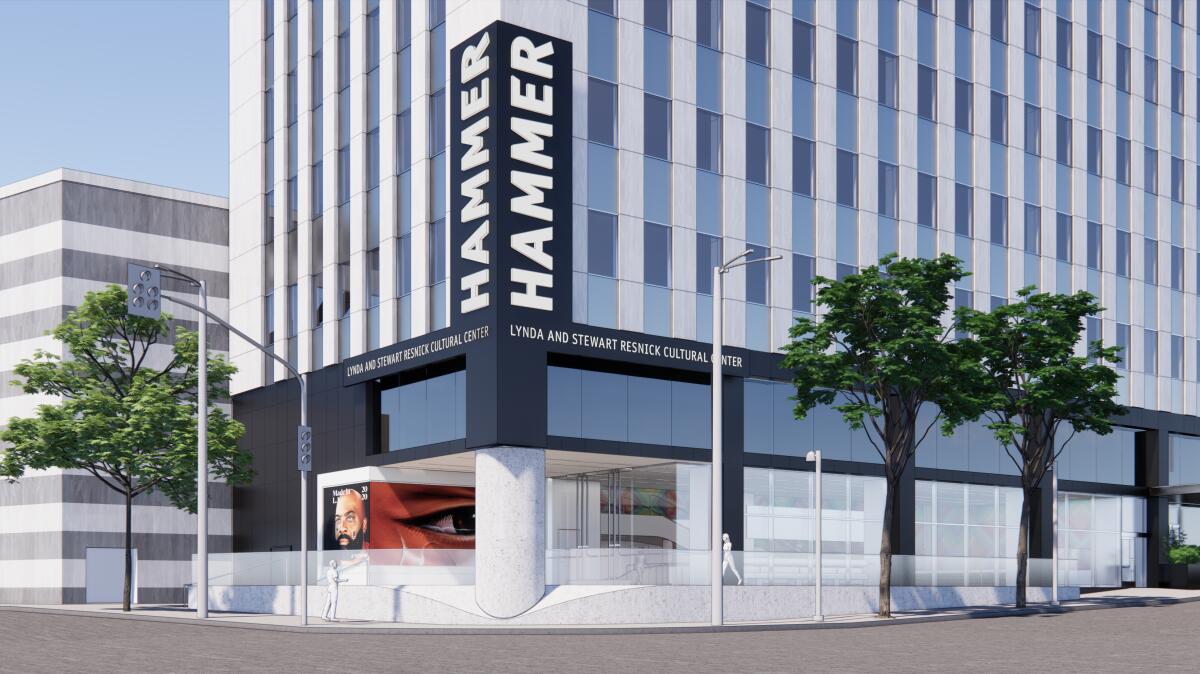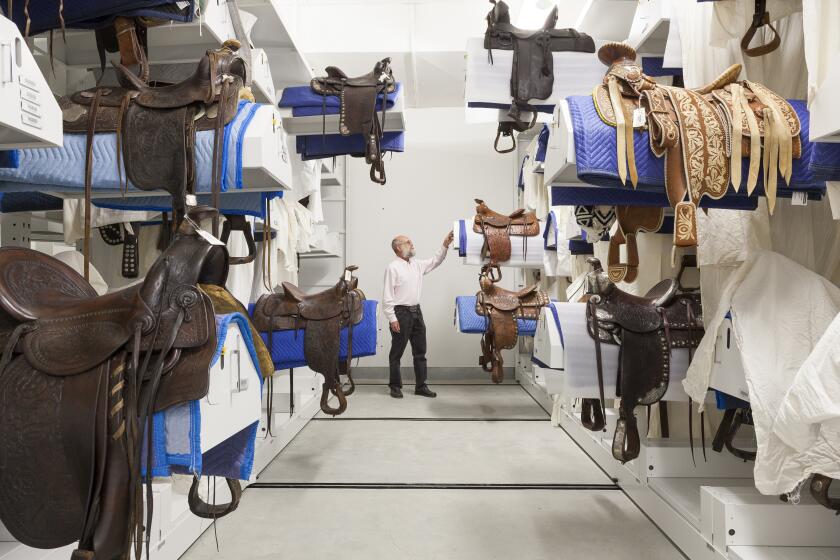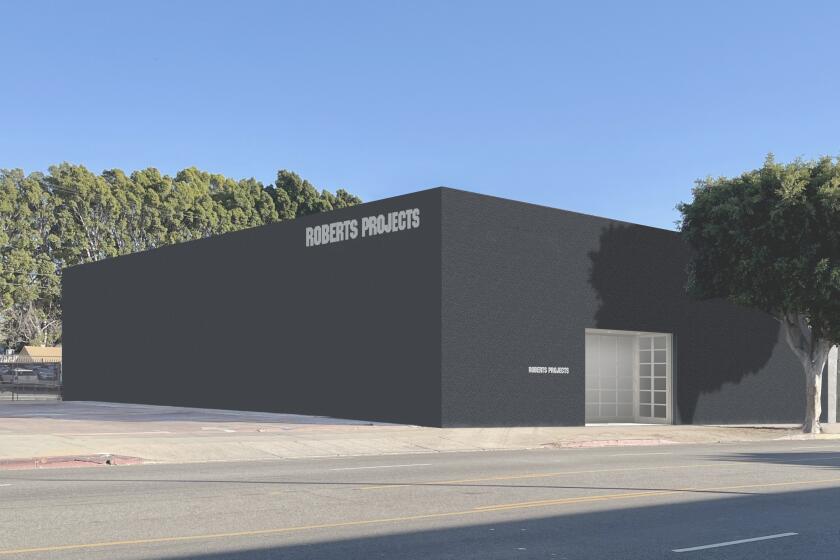L.A.’s Hammer Museum expansion, two decades in the making, sets date for the final reveal

- Share via
The Hammer Museum’s more than two-decade-long building transformation is about to cross the finish line: The museum said Tuesday it will premiere the final phase of its expansion and renovations project on March 26.
That includes a new, far more visible entrance on the corner of Wilshire and Westwood boulevards designed by Michael Maltzan Architecture, which has steered the project for more than 20 years. The new entrance faces the Metro D (Purple) Line station expected to open in 2027.
The March reveal will include new gallery space in the former City National Bank space next door and an outdoor sculpture terrace on the corner of Wilshire and Glendon Avenue. New art exhibitions and programming will mark the new spaces.
“It’s just incredibly exciting,” museum Director Ann Philbin said in an interview, adding that because construction was incremental over so many years, “it was hard to imagine an end to it. But now, this is the moment when we open the front door and the new entry, this is the moment when everyone’s going to really notice what we’ve been doing.”
The revamped main portion of the museum has been renamed the Lynda and Stewart Resnick Cultural Center after benefactors whose $30-million gift made it possible. The donation, announced in 2018, is the largest individual gift in the museum’s history. It was part of a $180-million capital campaign to which board chairwoman and television producer Marcy Carsey donated $20 million. The campaign, half of which goes toward building costs and half toward the museum’s endowment, operations and programming, now stands at $156 million.
The Autry Museum of the American West’s new $32-million Resources Center takes a big step toward healing relations with Native tribes.
The multiyear expansion project adds 40,000 square feet of space to the museum. About 10,000 square feet of that is gallery space, a 60% increase, bringing the total amount of exhibition space to 26,600 square feet. There’s also 20,000 square feet of enhanced public space, which includes a new restaurant, Alice Waters’ and David Tanis’ Lulu, which opened in 2021. New administrative offices use another 10,000 square feet.
In 2017, the Hammer opened its renovated third-floor galleries; in 2018, it debuted a newly imagined courtyard performance space along with a gallery for new media art. The Annenberg Terrace for education, installations and programming, featuring ping pong tables and couches, opened in 2019. A works-on-paper gallery and a study room for the museum’s Grunwald Center Collection opened earlier this year along with the museum’s renovated store. In 2014, the Hammer instituted free admission (regular adult entry had been $10).
The expansion is the culmination of Philbin’s longtime vision. She joined the museum in 1999 when it had fewer than 50 full-time employees and a $6-million annual operating budget. It now has more than 100 full-time employees and a $29-million annual budget. Since the expansion project began in 2000, attendance has quadrupled.
The museum also has been collecting contemporary art since 2005, much of it from L.A. area artists in its “Made in L.A.” biennial exhibitions. It’s also acquired work by international artists, much of it from its Hammer Projects series. This spring, in conjunction with the opening of the new building, the museum will present the largest exhibition to date of its Hammer Contemporary Collection. So March 26 will be a celebration of the museum, architecturally and programmatically.
“It’s not just about the physical transformation of the building, it’s also about building the contemporary collection. It’s the culmination of two major endeavors,” Philbin said.
Maltzan said in the announcement that when he first got involved with the project, the Hammer was “a cloistered, private museum of historic European painting.” Philbin’s vision for how to transform the institution, he said, “sustained us through a process that demanded extraordinary persistence and inventiveness, because we needed to work in phases as we reshaped, reconfigured, opened and expanded the Hammer. This was truly a case of building the airplane while you were flying it. I can’t think of any other client that would have had the daring and imagination to carry it off.”
The Los Angeles museum scene is ballooning. Last year the Academy Museum of Motion Pictures opened. This year saw the openings of the Orange County Museum of Art building in Costa Mesa and the Autry Museum of the American West’s new Resources Center in Burbank. Next year’s Hammer debut happens around the same time as the scheduled opening of the 1.3-mile public art corridor, Destination Crenshaw. Meanwhile, the Los Angeles County Museum of Art’s new building and the Lucas Museum of Narrative Art are under construction, the former aiming for a 2024 completion, the latter to open in 2025.
“For the last couple of decades, the museums have been growing and their ambitions have been on display,” Philbin said. “And I think this is just a matter of the city being ready, both from the point of view of the ambitions of people working in these institutions, but also the philanthropy around them ready to make these institutions what they can and should be.”
For the record:
12:05 p.m. Nov. 30, 2022A previous version of this article incorrectly stated that works by the artists Chiharu Shiota and Sanford Biggers are a part of the Hammer Museum’s permanent collection.
When it debuts, the new Hammer lobby will feature an installation by Japanese artist Chiharu Shiota, while the street-level, 5,600-square-foot annexed gallery will show Rita McBride’s “Particulates,” a large-scale installation featuring commingling lasers and mist. The 900-square-foot sculpture terrace will feature Sanford Biggers’ monumental, 25-foot-tall cast bronze sculpture “Oracle,” which is part of the artist’s “Chimera” series and was previously on view in New York’s Rockefeller Center.
In addition to the Hammer Contemporary Collection exhibition, two additional exhibitions will be on view, both opening in February. “Bridget Riley Drawings: From the Artist’s Studio” is a retrospective of the British artist’s work — the most extensive ever organized, the museum said — co-organized by the Hammer with the Art Institute of Chicago and New York’s Morgan Library & Museum.
“Cruel Youth Diary: Contemporary Chinese Photography and Video from the Haudenschild Collection” will feature works from the ‘90s and early 2000s by artists such as Cao Fei, Weng Fen and Xu Zhen, gifted to the museum by the Haudenschild family.
“This is a really big deal for me — and the Hammer. It’s been a long time coming,” Philbin added of the March opening. “I’m just super proud of what we’ve accomplished in two decades.”
Roberts Projects is moving to a much larger space with a Betye Saar-designed installation space and new work by Kehinde Wiley.
More to Read
The biggest entertainment stories
Get our big stories about Hollywood, film, television, music, arts, culture and more right in your inbox as soon as they publish.
You may occasionally receive promotional content from the Los Angeles Times.













